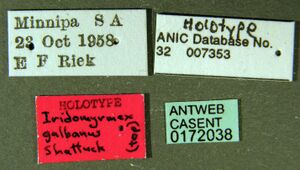Iridomyrmex galbanus
| Iridomyrmex galbanus | |
|---|---|

| |
| Scientific classification | |
| Kingdom: | Animalia |
| Phylum: | Arthropoda |
| Class: | Insecta |
| Order: | Hymenoptera |
| Family: | Formicidae |
| Subfamily: | Dolichoderinae |
| Tribe: | Leptomyrmecini |
| Genus: | Iridomyrmex |
| Species: | I. galbanus |
| Binomial name | |
| Iridomyrmex galbanus Shattuck, 1993 | |
Iridomyrmex galbanus is mainly confined to the Eyre Peninsula of South Australia, but scattered populations also occur in south-eastern South Australia and western Victoria. This species appears to favour certain soil types (Shattuck, 1993a).
Identification
Iridomyrmex galbanus shares with Iridomyrmex viridiaeneus greenish iridescence on the head capsule, but in the case of I. galbanus the head capsule is distinctly lighter in colour than the mesosoma (versus the same colour or only slightly lighter in I. viridiaeneus).
Keys including this Species
Distribution
Latitudinal Distribution Pattern
Latitudinal Range: -30.08333333° to -36.21666667°.
| North Temperate |
North Subtropical |
Tropical | South Subtropical |
South Temperate |
- Source: AntMaps
Distribution based on Regional Taxon Lists
Australasian Region: Australia (type locality).
Distribution based on AntMaps
Distribution based on AntWeb specimens
Check data from AntWeb
Countries Occupied
| Number of countries occupied by this species based on AntWiki Regional Taxon Lists. In general, fewer countries occupied indicates a narrower range, while more countries indicates a more widespread species. |

|
Estimated Abundance
| Relative abundance based on number of AntMaps records per species (this species within the purple bar). Fewer records (to the left) indicates a less abundant/encountered species while more records (to the right) indicates more abundant/encountered species. |

|
Biology
Castes
Worker
Images from AntWeb
   
| |
| Holotype of Iridomyrmex galbanus. Worker. Specimen code casent0172038. Photographer April Nobile, uploaded by California Academy of Sciences. | Owned by ANIC, Canberra, Australia. |
Nomenclature
The following information is derived from Barry Bolton's Online Catalogue of the Ants of the World.
- galbanus. Iridomyrmex galbanus Shattuck, 1993a: 121, fig. 10 (w.) AUSTRALIA. See also: Heterick & Shattuck, 2011: 83.
Type Material
- Holotype, worker, Minnipa, South Australia, Australia, Riek,E.F., ANIC32-007353, Australian National Insect Collection.
- Paratype, 5 workers, Minnipa, South Australia, Australia, Riek,E.F., ANIC32-007354, Australian National Insect Collection.
- Paratype, 2 workers, Minnipa, South Australia, Australia, The Natural History Museum.
- Paratype, 2 workers, Minnipa, South Australia, Australia, Museum of Comparative Zoology.
Description
Worker Description. Head. Posterior margin of head weakly concave; erect setae on posterior margin in full- face view set in a row; sides of head noticeably convex; erect genal setae present on sides of head in full-face view, or absent from sides of head in full-face view (one to a few small setae may be present near mandibular insertion). Ocelli absent; in full-face view, eyes set at about midpoint of head capsule; in profile, eye set anteriad of head capsule; eye semi-circular. Frontal carinae convex; antennal scape surpassing posterior margin of head by approximately 3 x its diameter. Erect setae on scape present and abundant; prominence on anteromedial clypeal margin projecting as triangular spur; mandible elongate triangular with oblique basal margin; long, curved setae on venter of head capsule present in some workers. Mesosoma. Pronotum moderately and evenly curved over its length. Erect pronotal setae numerous (12 or more), short and bristly. Mesonotum sinuous. Erect mesonotal setae numerous (12 or more), short and bristly. Mesothoracic spiracles always prominent as small, vertical protuberances; propodeal dorsum smoothly and evenly convex; placement of propodeal spiracle mesad, more than its diameter away from propodeal declivity; propodeal angle weakly present or absent, the confluence of the dorsal and declivitous propodeal faces indicated, if at all, by an undulation. Erect propodeal setae numerous (12 or more), short and bristly. Petiole. Petiole dorsum of node acuminate; node thick, orientation more-or-less vertical. Gaster. Non-marginal erect setae of gaster present on first gastral tergite; marginal erect setae of gaster present on first tergite. General characters. Allometric differences between workers of same nest absent. Colour head orange, mesosoma brownish-orange, head and mesosoma with pink, green and yellow-green iridescence, gaster black with bright bluish- green and purple iridescence, legs brown. Colour of erect setae dark brown.
Measurements. Worker (n = 23)—CI 90–99; EI 17–21; EL 0.33–0.40; EW 0.21–0.26; HL 1.84–2.37; HW 1.68–2.3 1; ML 0.90–1.23; PpH 0.27–0.37; PpL 0.99–1.30; SI 87–103; SL 1.67–2.06.
References
- Heterick, B.E. & Shattuck, S.O. 2011. Revision of the ant genus Iridomyrmex (Hymenoptera: Formicidae). Zootaxa 2845: 1-175.
- Shattuck, S. O. 1993a. Revision of the Iridomyrmex purpureus species-group (Hymenoptera: Formicidae). Invertebr. Taxon. 7: 113-149 (page 121, fig. 10 worker described)
References based on Global Ant Biodiversity Informatics
- Heterick B. E., and S. Shattuck. 2011. Revision of the ant genus Iridomyrmex (Hymenoptera: Formicidae). Zootaxa 2845: 1-174.
- Shattuck S. O. 1993. Revision of the Iridomyrmex purpureus species-group (Hymenoptera: Formicidae). Invertebrate Taxonomy 7: 113-149.
- Shattuck S. O. 1994. Taxonomic catalog of the ant subfamilies Aneuretinae and Dolichoderinae (Hymenoptera: Formicidae). University of California Publications in Entomology 112: i-xix, 1-241.

